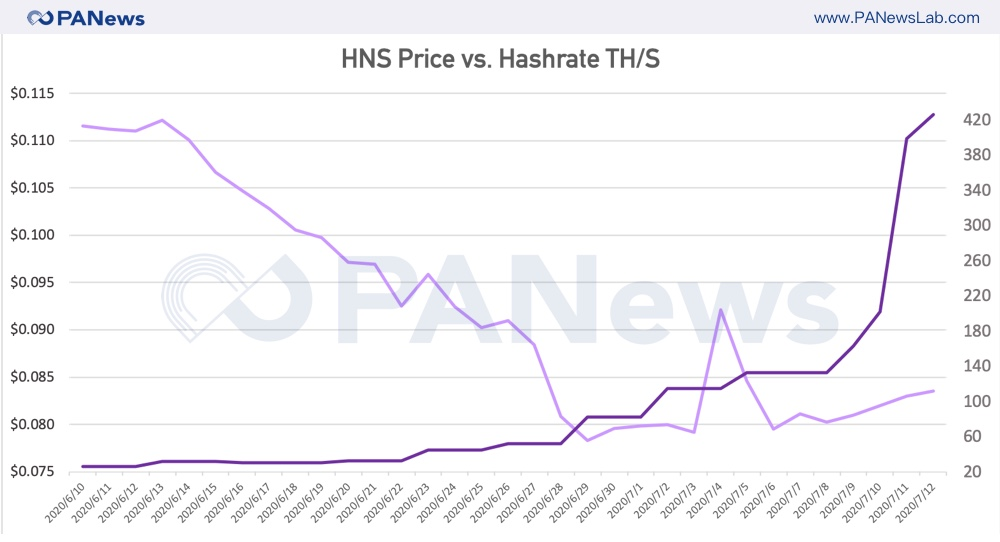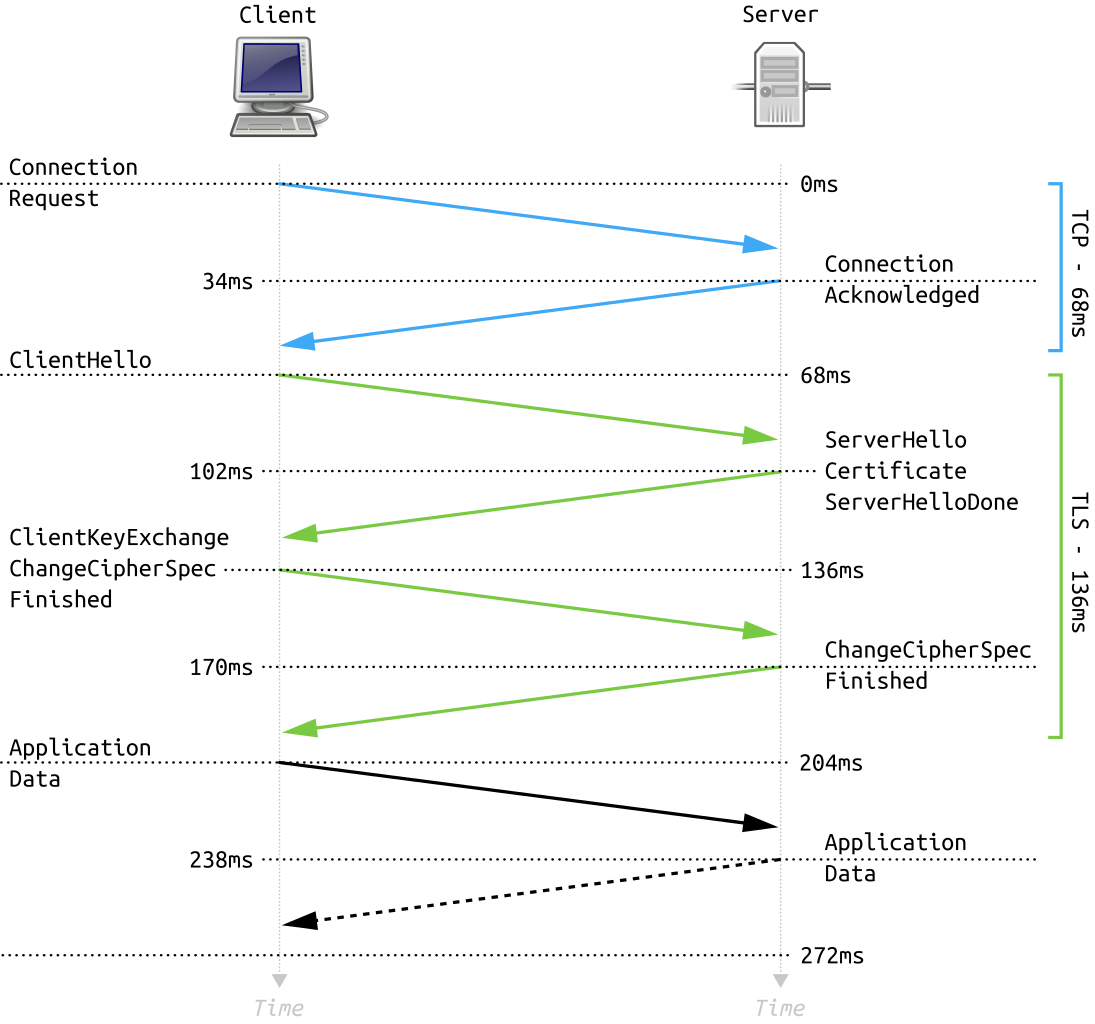July 13th, 2020 | A look into the Handshake Protocol and its recent run up in hashrates.

For a project that has basically been “quiet” compared to other blockchain protocols working in a anonymous-like fashion, the Handshake protocol has crept up in an apace way the past month by seeing its mining hash rate 16x from around 25TH/S to now over 400TH/S. Falling in line with theoretical PoW mining economics, the price of HNS followed suit in the opposite direction starting from around $0.11 on June 7th hitting an ATL around $0.075 on June 28th, now recovering towards $0.0911.

(Figure 1) HNS price and hash rate showing an inverse relationship over the past month. Data pulled from Handshake block explorer ShakeScan.
It’s quite clear now how COVID has vehemently altered our lives in many aspects that has caused us to flip the script on a lot of things we’ve never questioned before. Without needing to get into too much detail of what we have experienced over the past 7 months, but the word dystopian could be understandably emblematic of what we have seen play out. The draconian social distancing and stay at home measures have basically placed us to be on the internet more so than we were before. This has inadvertently called for the need of more security and sovereignty in our internet lives as we have seen good actors try to spread important information fall into the hands of government censorship or bad actors trying to take advantage of our naïve internet time.
It was understood from the beginning of how the developers behind the Handshake protocol was going to join the blockchain movement in a concerted effort from the start. Ultimately with the goal of democratizing the way domain names are bought and sold, giving a new standardization around the Root Name Server, which is currently controlled by ICANN. Last year ICANN was egregiously caught attempting to sell the .Org top level domain (TLD) to a private equity firm for a whopping amount of money. A bit more on this later but this spun the question of how more centralized the internet has really become?
The digital TLS handshake
For a brief primer of what the Handshake team is trying to do, it’s best to quickly have an understanding of where the name comes from. No it does not come from our normal polite way of greeting people in person as introduced earlier, which we all now are staring to yearn more of, but rather the digital “handshake” our internet browsers make with backend servers to deliver you your daily “needed” non-essential social media content. It is basically a way for our computers to verify that the internet website we are about to connect to is secure and safe through a cryptographic process that takes milliseconds. Uday Hiwarale does a terrific job of breaking down common standard SSL/TLS handshakes in this article if you want to understand deeper.
But for a brief illustration, it basically looks like a couple of back and forth request and receive messages from the client to the server illustrated in the below graphic as a waterfall like process.

(Figure 2) Graphic of the TLS 1.2 handshake taken from Wikimedia Commons. The newest upgrade is the TLS 1.3, which shortens the whole process even more.
The crux is when a client sends a request to the server, the server sends back a certificate, issued by a centralized trustworthy Certificate Authority (CA) and the public key to the client. This way the client can “trust” that the website is who they are supposed to be and then attaches a ‘pre-master secret’ back to the server encrypted with the public key given. But like with any centralized entity, attacks on these CAs have happened. What’s more alarming is how one CA provider actually has over a 50% market share of all CAs. And who’s to say that these centralized attacks can’t happen again?

1. In 2011, a Dutch certificate authority, known as DigiNotor, was quickly declared bankrupt after a security breach in their systems was found causing them to issue fraudulent certificates which then resulted in major web browsers to blacklist all DigiNotar certificates at the time.
2. In the same year, another certificate authority known as Comodo issued fraudulent certifications to users for many highly visited sites leading users to believe they were accessing these sites securely when in fact a MITM attack could’ve occurred.
3. And last but not least, the irony in ICANN being exposed for attempting to sell the rights of the more popular TLD, .Org, to a shady private equity firm set up by the former executive of ICANN. What’s more interesting about this news, which led to actual protests outside of ICANN’s offices, was the fact that this alleged sale was about to take place after the price cap of .Org domains was taken off earlier.

How the Handshake has been shakin’ up to be
It’s hard to say whether this project will take off since it merely was launched earlier this year with the help of Tieshun Roquerre and the team at Namebase attracting a more retail focused crowd by making it exponentially easier for a novice to purchase their own TLD and make tweeks to your DNS settings to access their Handshake domain names. And as true to the tune of decentralized and cypherpunk anonymity, the Handshake protocol has “no team” or “There is no official Handshake Foundation or entity.” Ultimately staying true to the ethos of blockchain in the same manner Bitcoin came about.
When analyzing on-chain data, it’s clear that the network is growing in strides based on the total HNS locked in current bids. Through the Handshake block explorer HNScan, by taking the amount of HNS burned and subtracting it from the total HNS locked, the correct amount of HNS locked in bids stands at roughly over $13 million. For comparison’s sake, the Ethereum Naming System (ENS), which only allows users to purchase a domain with the .eth suffix, has supposedly had over 170k ETH spent (much more now) on ENS during its over 3 year existence. But the biggest nuance between Handshake and ENS (or even Namecoin) is that Handshake allows for the purchase of TLDs.

Daily bids seem to be quite erratic with daily bids ranging from over 10,000 one day to just a measly few hundred on other days. But overall the months from April until now have shown more growth than the months before indicating increased community engagement.

(Figure 6) Snapshot of Daily Bids on the Handshake protocol taken directly from HNScan.
The HNS mining pool, 6Block, have been quite instrumental in the recent run up of the hashrate with their Mars H1 coming onto the market last month. One of 6Block’s team members informed me that “The recent HNS hashrate growth is partly beacuse of the Mars H1 miner shipment, but in the meanwhile, there’re also some other ASIC miners emerging in the market, which is also contributing to the network”. And what’s more surprising is that nobody is talking about this. But as recent word on the street of new HNS mining chips being created through Global Foundries and TSMC are starting to unfold, look for the hashrate to naturally rise up even further. Which is ultimately good for the network in attracting new miners to flow in to support this, one of the more truer, dissident blockchain tech protocols. But if HNS price keeps dropping, mining profitability would also just tank as it already has in the past week from around $12.35/day to a current reading of around -$3/day.
Conclusion
To step back for a quick second, it’s not that we should paint ICANN or CAs as total nefarious actors in the same way many Bitcoin maximalists are towards the central banks. I guess we could applaud their response to the cornovirus pandemic by allowing registrants to delay their domain name renewals. But was it pretty damn shady how the whole .Org fiasco unfolded behind our backs? Yes. How did they think they would be able to slide this past a community of hardcore developers whom, as stated sternly by Boyma Fahnbulleh, HATES CAs and entities like ICANN? Who knows. Has ICANN yet to formally explain the actions of what has happened? No. But as Vint Cerf has candidly explained in a more neutral manner, ICANN is operating at a more complex time than ever before supporting the current team in place while others in the community find it hard to see signs of it improving.
“Developers HATE CAs “ — Boyma Fahnbulleh
Or maybe the community should focus on other aspects such as getting DNSSEC as a standard? The goal of Handshake is not too ultimately takedown ICANN but rather let them do their thing while Handshake does their own thing. The top established TLDs are already reserved from bidding on in the Namebase exchange leaving us with more creative TLDs we could all individually decide to own.
See below for a current snapshot of what’s trending in top listed TLDs to bid on (excluding some outliers):

With HNS still near all time lows facing the ever common question of “when moon”?, or at least back over its ATH of $0.40 back on March 6th, it’s better to realize the functionality that it is meant to solve as we precariously all become ingrained to the internet, especially more so than before. This is only year one of the Handshake protocol. And a matter of fact, this isn’t the first attempt at restructing CAs and root servers, IBM has put its own literature on managing certificates on their IBM blockchain platform. There are numerous PhD style research thesis proposing using smart contracts and a blockchain in securing TLS connections such as the ETDA and the CertChain. But as we see this network’s usage become more pervasive due to current global-social economics exacerbating our reliance on a trust-less root level of TLDs, the irony of the Handshake protocol beginning during a period when handshakes became taboo will be another win for the Web 3.0 movement.
Sources
- https://w3techs.com/technologies/overview/ssl_certificate
- https://learn.namebase.io/about-handshake/about-handshake
- https://shakescan.com/
- https://cacm.acm.org/magazines/2018/12/232883-self-authenticating-identifiers/fulltext
- https://hackernoon.com/the-certificate-authority-vs-the-handshake-33ccf214d8a2
- https://hnscan.com/











